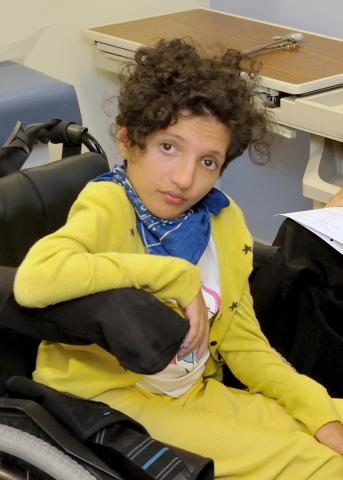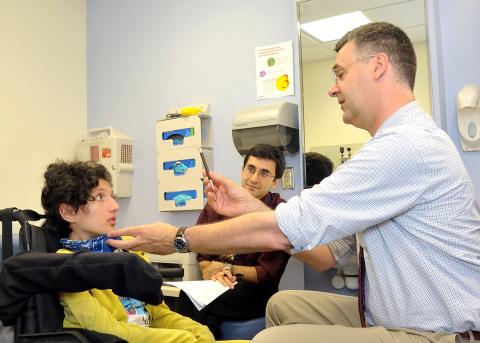Mysterious Illness Defined
NIH, USUHS Scientists Discover New Form of ALS

Photo: Michael Spencer
Five years ago, a 15-year-old girl from Santeramo in Colle, Italy, traveled to the United States hoping to learn more about her mysterious illness. More specifically she wanted to find a name for her condition, learn about possible treatments and perhaps even find a cure for the rare, yet undiagnosed, neurological disorder she had been suffering from since age 5. Her doctors in Italy had not been able to provide her with a diagnosis or effective treatment. Her story was shared in a 2015 NIH Record article.
Fast forward 5 years later—thanks to her team of NIH researchers with the help of scientists from the Uniformed Services University Health System (USUHS)—20-year-old Claudia Digregorio now has a name for her ailment.
In a recent study published in Nature Medicine, the scientists describe their pursuit of Digregorio’s mysterious illness and their discovery of a new, unique form of amyotrophic lateral sclerosis (ALS).
ALS is a rapidly progressive, often fatal disease that affects the nerve cells in the brain and spinal cord that control voluntary muscle movement. Symptoms most commonly develop between ages 55 and 75.
The NIH team led by Dr. Carsten Bönnemann, chief of the neuromuscular and neurogenetic disorders of childhood section in NINDS’s Intramural Neurogenetics Branch, worked with scientists in labs led by Dr. Teresa Dunn, USUHS professor and chair, and Dr. Thorsten Hornemann of the University of Zurich in Switzerland. Together their research further revealed that this new form of ALS is linked to a gene called SPTLC1—part of the body’s fat production system.
“We found that this new genetic form of the disease can affect children in particular,” said Bönnemann.
For 5 years, NIH researchers studied Digregorio’s clinical symptoms, data gathered from her neurological examinations and her DNA—along with data from 10 other people who had similar symptoms. Many patients required a wheelchair to get around and a tracheosotomy (a tube inserted in the neck to allow air to the lungs) to help them breathe. They all had hallmarks of ALS such as severely weakened or paralyzed muscles and muscle atrophy.
In addition to Digregorio, study participants included a patient Bönnemann’s team identified in one of their travel clinics. The team visits other medical centers around the world and uses advanced genetic techniques to solve some of the most mysterious pediatric cases of neurological disorders.
For this study, the team posted genetic information they collected in a gene “matchmaker” program and found other patients—who were identified and evaluated by collaborators. The data was shared and the study population increased to 11.

Photo: Michael Spencer
“These patients had many of the upper and lower motor neuron problems that are indicative of ALS,” said NIH clinical research fellow Dr. Payam Mohassel, lead author of the study. “What made these cases unique was the early age of onset and the slower progression of symptoms. This made us wonder what was behind this distinct form of ALS.”
Upon learning the diagnosis, according to Bönnemann, the patients and their families felt a sense of relief and gratitude that they finally had an answer to the mystery.
“But then naturally there’s always the question: What can we do now that we know what causes this?” he said. “And that is the real challenge, which we are trying to address next.”
Preliminary results from the study suggest that genetically silencing SPTLC1 gene activity may be an effective strategy for combating this form of ALS. The team plans to conduct additional basic studies to further define the mechanisms.
“Finding viable and rational therapeutic approaches is obviously the next important step,” Bönnemann noted. “This work really underscores that everything we do starts with the patients and eventually leads back to the patients, and sometimes even only one patient can get it started (such as was the case here). Claudia was our index patient. It was her mysterious symptoms that triggered the team’s search for answers and subsequently led to this study. It also shows that findings in an ultra-rare genetic disorder can lead to a broader understanding about many things—in this case ALS as a disease group and about the critical role of tight regulation of these important lipids (fats) in neurons.”
To read about Digregorio’s initial NIH visit, go to https://nihrecord.nih.gov/sites/recordNIH/files/pdf/2015/NIH-Record-2015-10-23.pdf.
